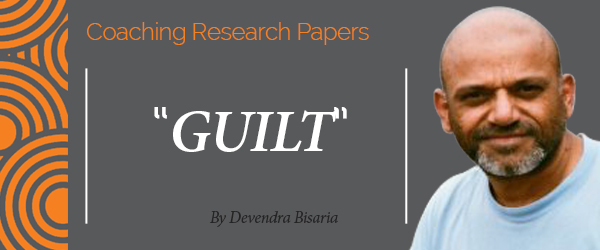Research Paper By Devendra Bisaria
(Life Coach, SINGAPORE)
Guilt is a useless feeling. It’s never enough to make you change direction–only enough to make you useless. Daniel & Dina Nayeri, Another Faust
No amount of guilt can change the past and no amount of worrying can change the future. Umar ibn Al-Khattab
What is Guilt?
Some of the dictionary definitions of guilt are:
- A feeling of responsibility or remorse for some offense, crime, wrong, etc., whether real or imagined. [3]
- Remorse or self-reproach caused by feeling that one is responsible for a wrong or offence [4]
Wikipedia defines guilt as a cognitive or an emotional experience that occurs when a person realizes or believes—accurately or not—that he or she has compromised his or her own standards of conduct or has violated a moral standard, and bears significant responsibility for that violation. It is closely related to the concept of remorse. [1]
This concept of guilt, built as it is on our own individual moral standards and codes, is useful as a behaviour moderator since
Feelings of guilt can be highly unpleasant, and may lead to anxiety, sadness, depression, or self-loathing. [2]
Ergo, we would avoid guilt and by definition the actions that would give rise to it. This is also known as reciprocal altruism.
However, apart from this singular application, guilt is generally a negative force, as we will see later, acting as an inhibitor and restricting possibilities.
Guilt is also distinct from shame –
While guilt is associated with a specific real or perceived transgression, shame is a feeling about oneself. Guilty people think, ‘I did something bad,’ while people think, ‘I am bad’ when they feel ashamed. [2]
A key differentiator of guilt types as noted by Martin Buber – the Freudian sense of guilt, based on internal conflicts and existential guilt, based on actual harm done to others. [1]
So, There are several types of guilt, including but not restricted to:
Guilt generally relates to events or actions in the past [there can be anticipatory guilt – see below]. Most frequently, those actions are ours directly although we can also be indirectly culpable by way of omission or commission.
The actions can be further be divided into two categories – first, those that have caused harm or pain in some form to someone else. It is also a fundamental truth of guilt that the more we care about the affected person, the stronger is the feeling of guilt and remorse. This is emotional guilt.
Second, those that have societal impact, as in a breach of the law or some sort of prohibition, but without direct impact on any other persons, rarely give rise to guilt creation. If there is guilt it is moral rather than emotional.
We can identify the following key ingredients for enabling guilt
Guilt and structures
There can be instances of such reinforced guilt that the cause and affect become inverted. The guilt becomes a vital emotional structure and takes on a life of its own. It becomes the justification for not taking risks in future. In that sense the guilt becomes self-perpetuating and acts as an anchor, preventing the person from rationalizing it and moving on.
The effort required to rationalize the historic source event and view it in its correct perspective, ie, something that has occurred in the past and is over, is considerable. Looking forward is not easy. Occasionally, sheer laziness and sense of comfort can prevent the move forward – it is easier to live the status quo than confront it. And yet, confronted it must be, if one is to leave the past in the past and move into the future.
In order to do so, the guilt structure must be dismantled and replaced by forward-enabling structures of positivity and risk-taking.
